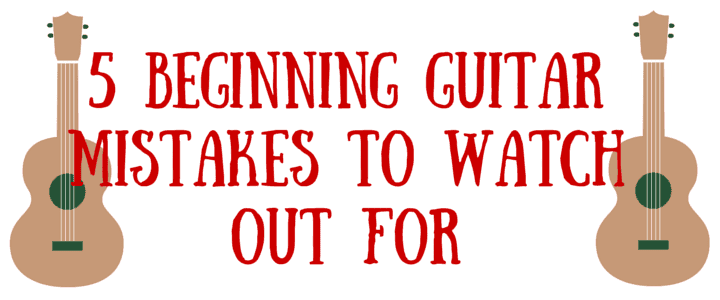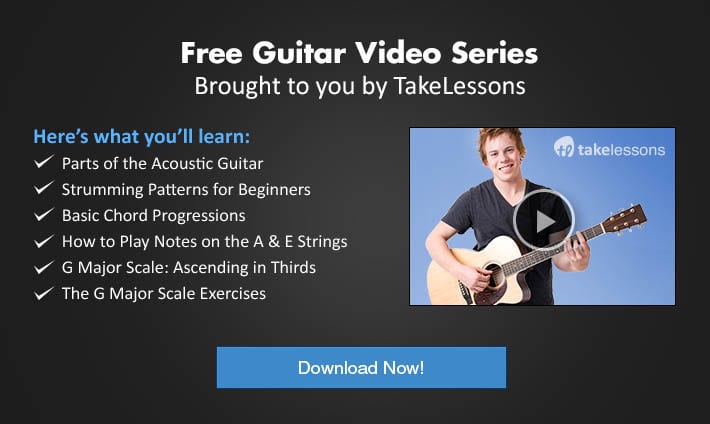Are you excited to begin learning to play the guitar? To help you get started, guitar teacher Noel S. made this list of the five most common mistakes beginning guitarists make…
1. Angling the guitar too far back so you can see better.

Many students who have just begun guitar lessons tend to angle the guitar towards themselves too much to see the fretboard and right hand picking area better. However this position puts your left wrist in a bad position because it’s operating within an extreme range of movement.
Muscles function most efficiently within their midrange of movement. You’ll just develop bad contact and movement habits instead of developing good coordination, minimal left hand pressure, and good finger contact habits.
Remember, you have two other senses involved in playing the guitar; use your sense of hearing and your sense of touch also! Angle your guitar back just a little, then adjust your vision to get accustomed to viewing the strings and fretboard from a slight angle.
You’ll be able to see everything just fine; also be aware of the information being received from your senses of touch and hearing.
2. Holding the pick at too much of an angle to the strings.
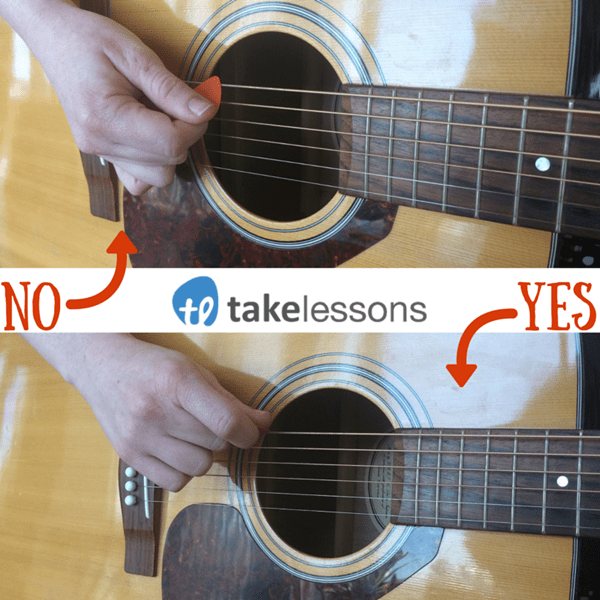
Many students start out with downstroke picking, and hold the pick angled towards the floor to facilitate downstrokes.
This makes it harder though, to execute an uppick. Holding the pick perpendicular to the strings will result in good right hand coordination as you launch into alternate picking. In addition, practice using minimal movement away from the string, as you will have to travel that same distance back to the strings in order to pluck again.
3. Not contacting the strings on the lefthand fingertips.
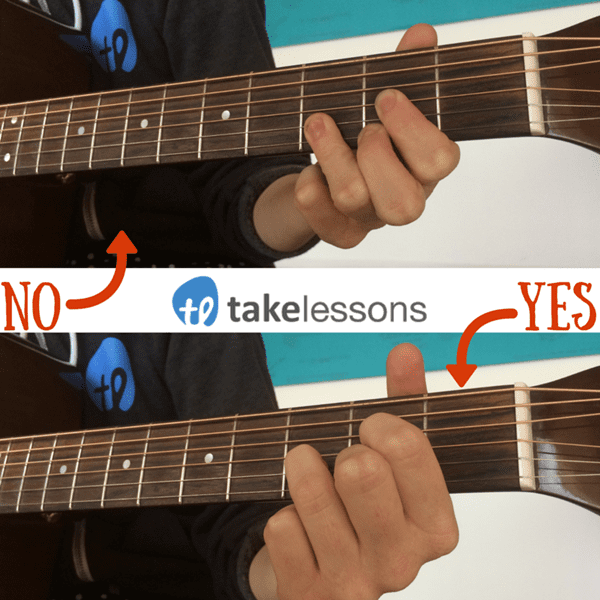
Many students start out contacting the string with the fingerprint pad of their left hand. Remember what I said in the first point about muscles functioning most efficiently in their midrange of movement? Contacting the string on the back fingerprint pad puts your middle and tip joints in their fully extended range, and you need them for the following functions:
- The big knuckle joint moves the finger on and off the string.
- The middle joint moves the finger from one string to another, changing strings.
- The tip joint facilitates the application of the pressure needed to push the string down until it touches the metal fret bar.
- Contacting the string on your fingertip allows each of these joints to maintain a good curve, right in the midrange of movement, where your have the most strength to use your finger muscles.
This brings up a related point and a cool beginning guitar exercise about just how much pressure is needed to move the string until it touches the metal fret.
First of all, contact the string as close to the metal fret bar (the right side of a fret, not the left side) as possible. It makes sense that if it’s your goal to push the two together until they meet, start pushing at a contact spot as close as you can to their meeting point.
Then, without pushing at all (just touching the string), begin to pluck. Gradually apply more and more pressure until you hear a buzzy-sounding note.
Finally, apply just a little more pressure until you hear a clear and correct sounding note. Practice releasing and applying pressure to activate buzzy notes and clear ones alternatively as an exercise to help you learn correct left hand pressure levels.
4. Disregarding fingering information.
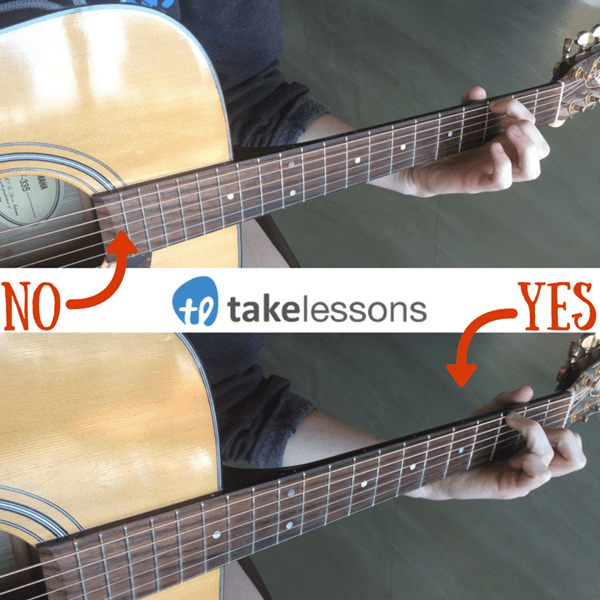
Your teacher and method book give you finger indications for the left hand, for example, playing a first string “g” note with your ring finger as in the photo above. Follow fingerings consistently to get on the fast track to performing your music!
Why do we practice? To set up the neural and muscular pathways, or patterns, for performance; your presentation of the music will “just happen” because you’ve already established good habits from rehearsing the music correctly. Plus, you’ll avoid moments of confusion or hesitation in which you don’t have time to analyze, think about and decide what finger to use, then desperately grab for a note.
Remember, it’s called music; to muse, or to be amused, is the whole point. That’s what happens when you practice correctly, not what happens when you’re navigating nervously around the music, with random fingerings, like you’ve got a “tiger by the tail”.
5. Inefficient Practice Habits
Not knowing how to practice, not practicing much at all, or searching for that magical 101st attempt when, “I’ve finally got it!”. No, the student doesn’t actually “have it”; he or she has instead, 100 incorrect rehearsals of that musical passage, or guitar riff.
Give yourself a chance to get it right a few times, as many as five repeats. If the music’s still not the way it should be, slow down your tempo to a manageable one. Isolate a smaller part of the music. Once you’ve got that, try it again at full speed.
I regularly drop from 160 beat per minute performance tempos down to 80 bpm to practice my music correctly if it’s not exactly the way I want it. Then I hit it again at 160. If I need to, I’ll drop back again to 100, then 120, and so on.
What’s happening here? I’m getting the song or isolated passage correct, over and over again. There’s a huge difference here (and it shows!) between this approach and the “magical 101st attempt” approach.
Along the same lines, beginning guitar students often get so focused on playing the correct pitch, they forget about playing in time. Maintaining a steady pulse represents the first skill a guitar student needs in order to make music. Get a metronome as soon as you can after starting to learn the guitar, and make use of guitar tablature that either includes the correct rhythms or at least refers you to a good audio representation.
You’ve chosen one of the best instruments in the world to learn; that’s why so many people play guitar. Soon you’ll be performing at your best, even beyond what you thought you could accomplish!
 Noel S. teaches guitar, piano, and music theory lessons in Beachwood, OH. He holds a Masters degree in music from Dusquesne University and he has been teaching since 2001. Learn more about Noel.
Noel S. teaches guitar, piano, and music theory lessons in Beachwood, OH. He holds a Masters degree in music from Dusquesne University and he has been teaching since 2001. Learn more about Noel.
Photo by
Megan L.
